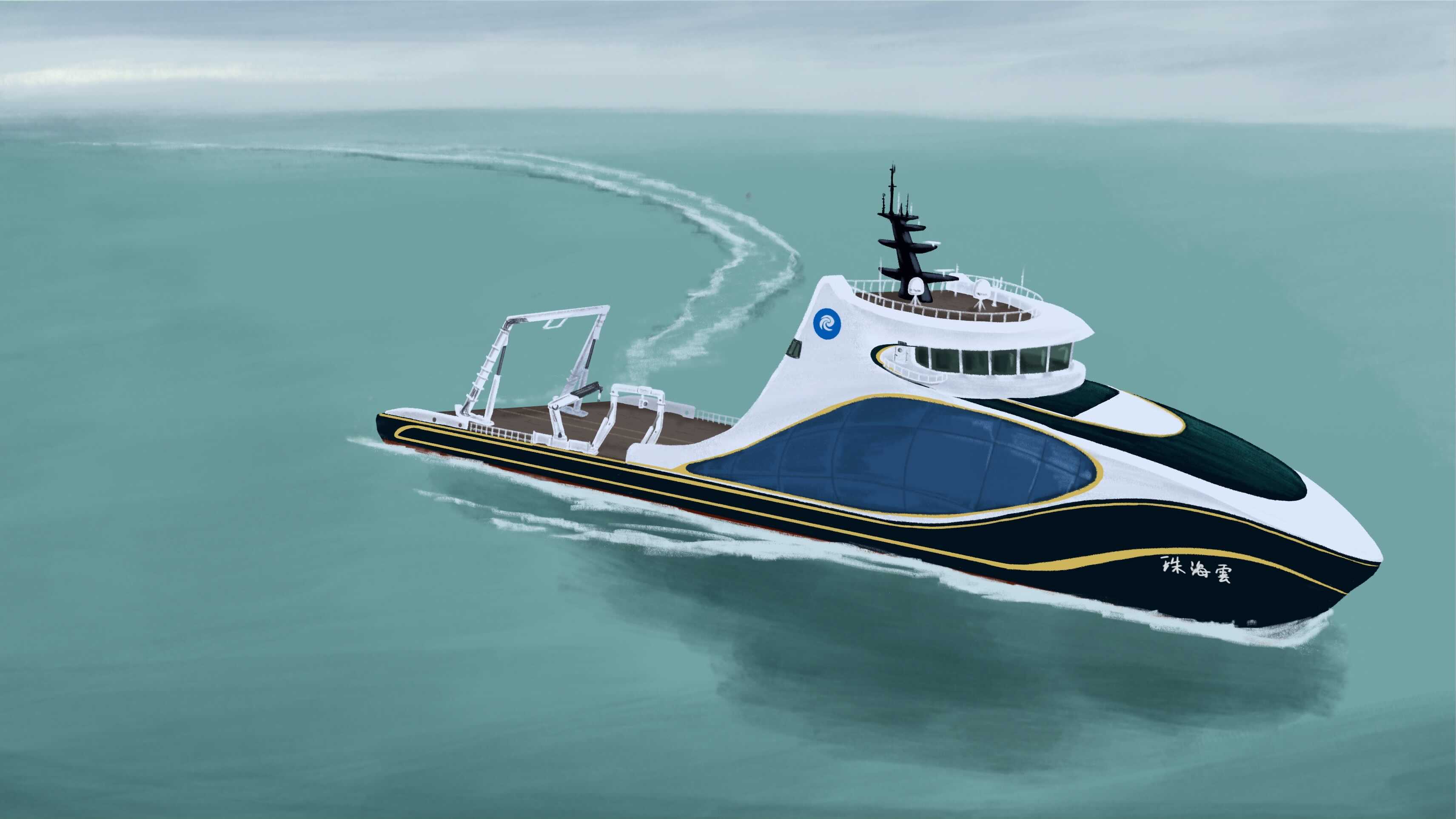In January 2023, China inducted Zhu Hai Yun amid much fanfare. The world’s first seaborne drone carrier, the Zhu Hai Yun, can function independently. A year later, a study revealed that it had already circumnavigated the Taiwan Strait, apparently on a mission to collect crucial intelligence.
The Zhu Hai Yun finally arrived at its home port of Zhuhai Gaolan in South China’s Guangdong Province in January last year, after a year-and-a-half of development. China says the vessel is the first unmanned system scientific research ship with autonomous navigation and remote-control functions. However, its operations may not be merely civilian.
A Washington-based think tank, the Center for Strategic and International Studies (CSIS), published a report on February 26 that made a serious revelation: the state-of-the-art Chinese research vessel had completed a remarkable and mostly unknown circumnavigation of Taiwan in late 2023.
The Chinese maintain the ship is only intended for civilian scientific purposes. The distinctions between the Zhu Hai Yun and the People’s Liberation Army (PLA) are, nevertheless, hazy.
Armed with cutting-edge monitoring and surveillance technology, the Zhu Hai Yun allegedly set a path that seemed intended to test Taiwan and investigate the surrounding waters amid rising tensions between the two sides. This was established by CSIS with the help of satellite imagery and other open-source information.
NEW: In late 2023, an advanced Chinese research vessel called the Zhu Hai Yun (珠海云) circumnavigated Taiwan in a rare move intended to challenge the island and probe its maritime environment.
Our new @HiddenReachCSIS report reveals the ship's ties to China's military. pic.twitter.com/G4OIjTKtLe
— Brian Hart (@BrianTHart) February 26, 2024
The Zhu Hai Yun sailed toward Dalian in the north on October 30, 2023, departing from its home port in southern China. The ship moored in Dalian at a pier run by the Dalian Institute of Measurement and Control Technology.
Since researching ship vibration and acoustics for the Chinese navy is one of the institute’s main responsibilities, the vessel was assumed to be engaged in a completely harmless and inconsequential activity.
However, Zhu Hai Yun took a rather unusual path home, as opposed to sailing back home through the Taiwan Strait. It appeared to have carried out a research mission when it slowed to a crawl in the waters off the northern coast of Taiwan. Then, on an unusual route for a civilian Chinese research ship, it sailed east of the island.
Nearly 24 nautical miles off the coast of Taiwan, the Zhu Hai Yun passed almost exactly in the contiguous zone of the island, appearing to momentarily enter into it. This was, besides the many PLA Navy vessels that unapologetically enter Taiwanese waters every other day to intimidate the establishment and military of the self-ruled island state.
China has made no bones about the fact that it would eventually make use of military force to capture and integrate Taiwan into the Chinese mainland. The Chinese leadership views Taiwan as a renegade province that has to be tamed and united with the country.
Although military pundits believe that a Chinese invasion is not imminent, US military officials have warned against complacency. President Biden’s nominee for head of the US Indo-Pacific Command, Admiral Samuel Paparo, issued a warning that China would soon be able to use military drills to conceal an invasion of Taiwan.
Despite reports of China grappling with economic and demographic woes, along with corruption scandals in the PLA, Paparo cautioned that Beijing’s leadership remained “undaunted in their ambitions.” He noted that these goals encompassed the West Pacific, the South China Sea, the world, and “more acutely for Taiwan.”

Chinese President Xi Jinping told US President Joe Biden in December 2023 that Beijing would reunite Taiwan with mainland China, although the exact date had not been determined. The Chinese leader referred to publicly-stated forecasts made by American military officials that suggest Xi intends to annex Taiwan in 2025 or 2027. However, he told Biden that these estimates were inaccurate because he had not specified a deadline.
Despite that, Beijing has consistently tried to prepare for a successful invasion attempt. This includes frequent military drills in the strait, simulating encirclement of Taiwan, practicing staging of an amphibious assault, and cutting off external interference in case military operations are launched.
The examination of the Taiwan waters using the research vessel Zhu Hai Yun could also be a step in that direction.
Testing The Taiwanese Waters, Literally!
China is notorious for using its civilian-use research vessels to snoop on hostile countries and collect crucial intelligence. These vessels are often seen near oil exploration sites within the exclusive economic zones of Malaysia and Vietnam in the South China Sea, which Beijing has laid claim to. Now, they have reached Taiwan.
Chinese maritime research vessels have significantly expanded their incursions and have been just 24 nautical miles off the coast of Taiwan in recent times, the Financial Times reported. These moves signal Beijing’s expanding capability to monitor the region and gather information vital to naval warfare.
The Financial Times analyzed tracking data of nearly 80 ships from satellite data company Spire Global, which showed that the Zhu Hai Yun’s voyage was one of nine such “invasions” since September last year: a dramatic increase from only two in each of the preceding three years.
States are granted resource rights and jurisdiction over the surface and bottom of an oceanic area up to 24 nautical miles from their shore under the UN Convention on the Law of the Sea. However, Taipei cannot use this international legal framework’s protection due to Beijing’s claim over Taiwan and its waters, which Beijing threatens to impose militarily if Taipei refuses to submit to its ruling.
According to reports, China has conducted in-depth surveys in the Indian Ocean, around Japan, and the US Pacific territory of Guam — all vital locations for underwater combat in the event of a US-China confrontation.
A military expert who didn’t want to be named told EurAsian Times, “The next big showdown is expected to take place in the Taiwan Strait, and if it happens, it will involve countries like the US and Japan. China knows it will not be a cakewalk for them, so they are likely studying the waters to devise fool-proof strategies.”

The pressing of Zhu Hai Yun in Taiwanese waters is significant. The Zhu Hai Yun stands out even among the most sophisticated vessels in China’s research navy. With the ability to be deployed from its deck while in motion, it is intended to act as a “mothership” for more than 50 unmanned aerial, surface, and underwater vehicles.
These smaller platforms can simultaneously survey a three-dimensional area 4,000 meters above, 1,500 meters below, and 160 kilometers across by using the Zhu Hai Yun as their hub.
Such autonomous systems can work together in an “unmanned ship swarm” (无人船艇集群), operating as a force multiplier for survey activities, according to Yunzhou Tech, a significant unmanned surface vehicle (USV) company that assisted in the design of the Zhu Hai Yun.
These technologies have dual-use applications in addition to supporting scientific research for civilian purposes. Chinese naval experts have determined that side-scan sonar, one of the sophisticated instruments aboard the USVs and undersea gliders on board the Zhu Hai Yun, helps to locate underwater targets like mines and submarines. Target regions can be observed or surveilled from the air using other devices, such as aerial drones.
Additionally, China can conduct live tests of networked drone swarm operations on the vessel, an area of growing interest for US and Chinese military strategists. These strategies, which entail flooding enemy defenses with waves of inexpensive unmanned vehicles, have fundamentally changed the face of contemporary fighting in Ukraine.
These will likely play a significant role in any potential conflict involving Taiwan.
- Contact the author at sakshi.tiwari9555 (at) gmail.com
- Follow EurAsian Times on Google News




